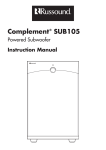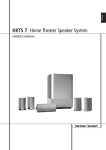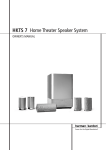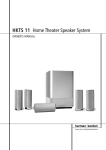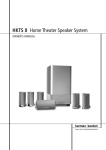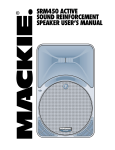Download Audioaccess AAS88 Owner`s manual
Transcript
JBLP1948-AAS88 OM 5/26/05 3:58 PM Page 1 ® ® AAS SERIES AAS88 OWNER’S GUIDE JBLP1948-AAS88 OM 5/26/05 3:58 PM Page 2 THANK YOU FOR CHOOSING AUDIOACCESS In 1987, Audioaccess pioneered the development of whole-house audio systems that combined superlative audio performance with a proprietary easy-to-use keypad system. With the introduction of the AAS Series of in-wall loudspeakers, Audioaccess expands its product line to include one of the most critical components in any audio system – the speaker. We are confident that when combined with our controllers, amplifiers and touchscreen keypads, AAS Series in-wall loudspeakers will be an essential part of a complete high-quality distributed-audio system that will be enjoyed for many years to come. Please take a moment to register your product on our Web site, www.audioaccess.com. Doing so enables us to keep you posted on our latest advancements, and helps us to better understand our customers and build products that meet their needs and expectations. – Audioaccess INCLUDED AAS88 Template and paint shield. One loudspeaker with grille. Logo to be attached to grille depending on vertical or horizontal installation. 2 JBLP1948-AAS88 OM 5/26/05 3:58 PM Page 3 SPEAKER PLACEMENT Low-frequency sounds are normally omnidirectional, meaning the listener can’t tell where they are generated from. However, frequencies between 75Hz and 150Hz can be localized, especially at higher volume levels. Positioning your subwoofer as recommended will provide the most natural soundstage and imaging from your loudspeaker system. It is generally recommended that the speaker be installed so that the bottom of the speaker is approximately 12" from the floor. This is to help with the low-frequency loading (bass reinforcement). This also helps hide the speaker in a less visible place. In special circumstances, it is acceptable to install the speaker at any height on a wall. It is generally recommended that you install your AAS88 in-wall subwoofer along the same wall as the front loudspeakers. The AAS88 subwoofer is not video-shielded and should not be placed near a video display. Installing the AAS88 near a corner will tend to maximize low-frequency output. Be cautious when installing in a corner, to avoid a “boomy” sound. Also take into consideration any unusual features of the room, such as an alcove, which may tend to create a localized node that may affect bass response in that area of the room. Remember that these are just guidelines. Since every listening room is different, Audioaccess strongly recommends experimenting with the positioning of your subwoofer prior to cutting the wall to obtain the most pleasing results in your room. One technique that can help you find the ideal subwoofer location is to temporarily borrow a stand-alone subwoofer and place it near the main listening location. Then move around the room and determine where you hear the most pleasing bass performance. This would then be the ideal location for the subwoofer. When using two AAS88 in-wall subwoofers, you may need to be concerned about phase, as the sound waves may cancel each other out. If bass response seems low, try inverting the polarity on one subwoofer – i.e., connect the (+) terminal on the amplifier to the (–) terminal on the speaker, and the (–) terminal on the amplifier to the (+) terminal on the speaker. 3 JBLP1948-AAS88 OM 5/26/05 3:58 PM Page 4 SPEAKER CONNECTIONS Connection Tips Speakers and electronics have corresponding (+) and (–) terminals. Most manufacturers of speakers and electronics, including Audioaccess, use red to denote the (+) terminal and black for the (–) terminal. It is important to connect both speakers identically: (+) on the speaker to (+) on the amplifier and (–) on the speaker to (–) on the amplifier. Wiring “out of phase” results in thin sound, weak bass and a poor stereo image. With the advent of multichannel surround sound systems, connecting all of the speakers in your system with the correct polarity remains equally important in order to preserve the proper ambience and directionality of the program material. the bare end of the wire into the hole. Release the tab and gently tug the wire to ensure that it is secure. If two AAS88 subwoofers are used, the wires for both speakers should be the same length. If one speaker is placed closer to the amplifier than the other, hide the excess wire behind the wall. If bass response seems low, there may be a phase problem, with the sound waves from the two subwoofers canceling each other out. If bass response seems low, try inverting the polarity on one subwoofer – i.e., connect the (+) terminal on the amplifier to the (–) terminal on the speaker, and the (–) terminal on the amplifier to the (+) terminal on the speaker. To use the spring-clip-type terminals on the AAS88 loudspeaker, press the colored tab and insert To use the push-type terminals on the connections panel supplied with the optional AAS88BB “back box” enclosure, depress the colored cap until the pass-through hole in the binding post is revealed. While holding the cap down, insert the bare end of the wire, or a banana plug, into the pass-through hole. Release the cap and tug gently on the wire to ensure that it is secure. Connection Method #1, Using One AAS88 (Remove Shorting Straps) Receiver/Amplifier Speaker Outputs Left – Right + – + Since the AAS88 is a passive loudspeaker, only speaker-level connections are available. Depending on whether you are using a dedicated subwoofer amplifier or your main receiver/amplifier to power the AAS88, select one of the two connection methods that follow. Wire Length Up to 20 ft. Up to 50 ft. Greater than 50 ft. Recommended Size 16-gauge 14-gauge 12-gauge Connection Method #1, Using One AAS88 With Back Box (Remove Shorting Straps) Receiver/Amplifier Speaker Outputs Rear of AAS88 BLK + IN 1 – GRN J2 J1 AAS88 L3 L2 Right + – + C2 C1 ® C3 C4 L4 + IN 2 – BLK + OUT 2 – L1 + OUT 1 – Left – YEL/BLK YEL WHT/BLK WHT ORG/BLK ORG GRE/BLK GRE ORN – + INPUT 1 Front Left Speaker – + Front Right Speaker – + + INPUT 2 Front Left Speaker – 4 – – + OUTPUT 1 – + OUTPUT 2 Connections Panel of AAS88 Back Box + Front Right Speaker – + JBLP1948-AAS88 OM 5/26/05 3:58 PM Page 5 terminals to the corresponding terminals on your front left speaker, and the Output 2 terminals to the corresponding terminals on your front right speaker. You may wish to mount the AAS88 horizontally to preserve the stereo image of the left and right low frequencies. Connection Method #1 Use this method when you are using the AAS88 with your main receiver/amplifier. Connect the main left and right speakerlevel outputs on your receiver/ amplifier to the Input 1 (for left channel) and Input 2 (for right channel) connectors on the AAS88 loudspeaker or connection panel. Connect the Output 1 The AAS88’s onboard crossover feeds the low-passed signal (2nd order at 100Hz) to the AAS88 subwoofers, and the high-passed signal to the speaker-level outputs for connection to the satellite speakers. Connection Method #1, Using Two AAS88 Loudspeakers (Use Shorting Straps) Receiver/Amplifier Speaker Outputs Right Left – + – BLK + OUT 1 – BLK GRN J2 ® C3 L3 J1 ® C3 L3 C4 L4 + IN 2 – + IN 2 – + OUT 2 – C2 C1 AAS88 C4 L4 BLK L2 L1 C2 C1 AAS88 GRN J1 + IN 1 – + IN 1 – L2 L1 J2 + OUT 1 – Rear of Right AAS88 BLK ORN + OUT 2 – Rear of Left AAS88 + ORN Front Right Speaker Front Left Speaker – – + + Connection Method #1, Using Two AAS88 Loudspeakers With Back Boxes (Use Shorting Straps) Receiver/Amplifier Speaker Outputs Left – Right + – + Connections Panel of Left AAS88 Back Box YEL/BLK YEL – + INPUT 1 WHT/BLK – WHT + INPUT 2 ORG/BLK ORG GRE/BLK – + OUTPUT 1 Front Left Speaker – GRE – + OUTPUT 2 + Connections Panel of Right AAS88 Back Box YEL/BLK YEL – + INPUT 1 WHT/BLK – WHT ORG/BLK + INPUT 2 ORG – + OUTPUT 1 GRE/BLK GRE – + OUTPUT 2 Front Right Speaker – + 5 JBLP1948-AAS88 OM 5/26/05 3:58 PM NOTE: When using Connection Method #1 with only one AAS88, the shorting straps must be removed. Page 6 that is occurring at the preamp stage. Connection Method #2 Use this method when you are using the AAS88 with a dedicated subwoofer amplifier. Connect your main receiver/processor’s linelevel subwoofer output to the linelevel input on your subwoofer amplifier. Connect the speaker terminals on your subwoofer amplifier to either Input 1 or Input 2. If your amplifier has stereo outputs, you may connect one channel to each of Inputs 1 and 2. However, you must remove the shorting straps when using stereo mode. Alternatively, you may connect each channel to a separate AAS88. When using only one input on an individual AAS88, you should leave the shorting straps in place. NOTE: The built-in network on the AAS88 is a 2nd-order lowpass filter, crossed over at 100Hz. This filter is always active. Although the subwoofer or LFE output on your receiver/processor may already be crossed over, the AAS88’s network will not interfere with the higher-order processing If you are using two AAS88 subwoofers, connect the left speaker outputs on your receiver/amplifier to Input 1 on one subwoofer (or the connections panel on its back box), and the right speaker outputs on your receiver/amplifier to Input 1 on the second subwoofer (or the connections panel on its back box). Then connect Output 1 from the left-channel subwoofer to the inputs on your main left speaker, and Output 1 from the right-channel subwoofer to the inputs on your main right speaker. When using the AAS88 in this mono mode, you should not remove the shorting straps. Using the AAS88BB Back Box Whichever connection method you choose, if you are installing the AAS88BB back box, you will need to connect all of the eight wires coming out of the bottom of the back box to the appropriate terminals on the loudspeaker. The wires are color-coded as follows: INPUT 1 (–): Yellow with black stripe INPUT 1 (+): Solid yellow INPUT 2 (–): White with black stripe INPUT 2 (+): Solid white OUTPUT 1 (–): Orange with black stripe OUTPUT 1 (+): Solid orange OUTPUT 2 (–): Green with black stripe OUTPUT 2 (+): Solid green Connection Method #2, Using One AAS88 in Mono Mode (Use Shorting Straps) Amplifier + + IN 1 – – L1 J2 J1 AAS88 L3 L2 C2 C1 ® C3 C4 L4 + IN 2 – BLK ORN 6 + OUT 1 – Rear of AAS88** Speaker-Level Outputs + OUT 2 – Line-Level Input BLK Subwoofer Out GRN Receiver/Processor JBLP1948-AAS88 OM 5/26/05 3:58 PM Page 7 Connection Method #2, Using One AAS88 in Stereo Mode (Remove Shorting Straps) Amplifier Receiver/Processor Line-Level Inputs Rear of AAS88** Speaker-Level Outputs J2 Right Right J1 AAS88 ® C3 L3 + Right C2 C1 C4 L4 + IN 2 – – L2 L1 Left + OUT 2 – Left Left + OUT 1 – BLK + GRN – + IN 1 – Subwoofer or Main Amp Out BLK ORN ** Use corresponding inputs on AAS88BB connections panel when installed with back box. Connection Method #2, Using Two AAS88 Loudspeakers With Back Boxes (Use Shorting Straps) Receiver/Processor Amplifier Subwoofer or Main Amp Out Line-Level Inputs Left Left YEL/BLK – + Left Right YEL – + INPUT 1 WHT/BLK – WHT + INPUT 2 ORG/BLK ORG – + OUTPUT 1 GRE/BLK GRE – + OUTPUT 2 Right AAS88 Back Box*** – Right Left AAS88 Back Box*** Speaker-Level Outputs + Right YEL/BLK YEL – + INPUT 1 WHT/BLK – WHT + INPUT 2 ORG/BLK ORG – + OUTPUT 1 GRE/BLK GRE – + OUTPUT 2 *** Use corresponding inputs on rear of AAS88 speaker when installed without back box. INSTALLATION The Audioaccess AAS Series in- Tools Needed wall speakers were designed to be easily installed. However, if you are unsure of your ability to properly install these loudPencil speakers, please contact your dealer or a qualified installer. Measuring tape Carpenter’s level Phillips-head #2 screwdriver Utility knife Awl 7 JBLP1948-AAS88 OM 5/26/05 3:58 PM Page 8 EXISTING CONSTRUCTION AAS88 Level Template The grille is packed separately from the speaker. If at some later date you wish to remove the grille from the speaker, to avoid scratching the grille or baffle you may unfold a paper clip, insert the straight end through one of the holes in the grille, and gently pull up. Determine the correct speaker location. NOTES: • Use the cardboard template when cutting the drywall. Although the AAS88 may be oriented either horizontally or vertically, the installation procedure is the same. • Please be aware the template is slightly oversized to allow for some margin of error when cutting with the drywall saw – there should be no need to allow for further margin of error as this may risk the integrity of the installation. 1/2" 1/2" 1/2" 8 NOTE: Always allow at least one-half inch between a wall stud and the speaker cutout, or the locking tabs will not be able to swivel into place. Cut the drywall. Connect the speaker wires to the speaker as described on pages 4–7. Place the frame assembly in the wall until the frame surface is flush with the wallboard. Screw down each of the ten Phillips-head screws. It is best to use a low-speed cordless driver or a handheld screwdriver to tighten the screws to prevent overtightening. The locking tabs will swivel into place and secure the unit to the rear surface of the drywall. Replace the metal grille. Attach the Audioaccess logo to the grille to correspond to vertical or horizontal installation. JBLP1948-AAS88 OM 5/26/05 3:58 PM Page 9 NEW CONSTRUCTION You may either purchase the optional AAS88 back box kit, or you may install the speaker after the wallboard has been installed by following the instructions for existing construction on page 8. See Detail A L-Brackets INSTRUCTIONS FOR INSTALLING THE AAS88 USING THE AAS88BB BACK BOX KIT The AAS88BB enclosure “back box” is optional. If desired, it is installed during new construction before the wallboard is installed. Detail B See Detail B Centering Bar Included With the AAS88BB: (4) L-brackets (8) #10 32 x 1" screws (8) #10 split washers (8) #10 flat washers (8) #8 x 3/4" woofer screws (2) wood centering bars (4) #10 32 x 1-1/2" flat-head screws 3. Fit the enclosure into the wall. The bottom edge of the bottom L-brackets will rest against the baseboard 2 x 4. At this time, make note of adjustments necessary to square the enclosure into the wall (see Detail C). Centering Bar Installation: 1. Install the two centering bars as shown in Detail B in the drawings. The centering bars are for setting the depth of the enclosure. They also help locate the left/right position of the enclosure as they can be mounted into the studs at the left and right to hold the enclosure in the correct location before final mounting. 2. Install the four L-brackets to the four corners of the enclosure. Each of the eight screws should have both the split washer and flat washer installed; the split washer goes on first. Leave the screws a half-turn loose at first to allow for adjustment later (see Detail A). Do not screw the L-brackets to the wall studs at this time (see step 6). Detail C See Detail C L-Brackets Detail A 4. After refitting and tightening the L-brackets into the enclosure (but not the wall studs yet), fit the enclosure into the wall once again. 5. At this time, you may want to screw through each side of the wood centering bars to mount the enclosure to the studs. This will help hold the enclosure in position before the L-brackets are mounted to the studs. 6. Screw the L-brackets into the studs. 9 JBLP1948-AAS88 OM 5/26/05 3:58 PM Page 10 7. Remove the wood centering bars and replace the flat-head screws into the holes left over (the holes left in the cabinet face underneath the bars are also counterbored to accept the flat-head screws). 8. The enclosure is now installed and ready for the wallboard to be installed over it. See Detail A 9. Make the connections from your receiver/amplifier to the AAS88 back box connections panel, and to any other speakers as appropriate for your system, following the instructions on pages 4–7. Connect the eight wires hanging from the bottom of the AAS88BB back box to the correct terminals on the AAS88 loudspeaker. See pages 6–7. PAINTING THE SPEAKER FRAME AND GRILLE Audioaccess AAS Series loudspeakers can be painted to match any décor. If you wish to change their color, the satin finish on the grille and frame will function as a primer coat. Before painting, install the plastic paint shield securely into the recess in the baffle. This will protect the speaker components and baffle from paint residue. Use a high-quality spray paint, and 10 apply a thin coat of color. Paint the grille separately from the baffle before installing it. Be certain the grille perforations remain free of paint. Filling them with paint will diminish the sound quality. JBLP1948-AAS88 OM 5/26/05 3:58 PM Page 11 TROUBLESHOOTING If there is no sound from any of the speakers: If there is low (or no) bass output: • Check that receiver/amplifier is on and a source is playing. • Check all wires and connections between receiver/amplifier and speakers. Make sure all wires are connected. Make sure none of the speaker wires are frayed, cut, punctured or touching each other. • Review proper operation of your receiver/amplifier. • Make sure the connections to the “Speaker Inputs” have the correct polarity (+ and –). If you are using two AAS88 subwoofers, try inverting the polarity on one subwoofer as described on page 4. • Consider adding a separate power amplifier to drive the AAS88 subwoofer. • In Dolby* Digital or DTS® modes, make sure your receiver/processor is correctly configured. When using a power amplifier with your AAS88 subwoofer, make sure the subwoofer output of the receiver/ processor has been enabled. See your receiver/ processor’s owner’s manual for further information on correct speaker configuration in Dolby Digital, DTS and other surround sound modes. If there is no sound coming from one speaker: • Check the “Balance” control on your receiver/amplifier. • Check all wires and connections between receiver/amplifier and speakers. Make sure all wires are connected. Make sure none of the speaker wires are frayed, cut, punctured or touching each other. In multichannel applications, make sure that your receiver/processor has been configured to enable all channels that you are using. If the system plays at low volumes but shuts off as volume is increased: • Check all wires and connections between receiver/amplifier and speakers. Make sure all wires are connected. Make sure none of the speaker wires are frayed, cut, punctured or touching each other. • If more than one pair of main speakers is being used, check the minimum-impedance requirements of your receiver/amplifier. 11 JBLP1948-AAS88 OM 5/26/05 3:58 PM Page 12 SPECIFICATIONS AAS88 Frequency Response Maximum Recommended Amplifier Power† Impedance Sensitivity Crossover Frequency Woofer Plate Size (W x H) Mounting Cutout Size (W x H) Mounting Depth Weight per Speaker 30Hz – 100Hz (–6dB) 250 Watts per channel 8 Ohms nominal per woofer 94dB (2.83V/1m), both woofers driven 100Hz, 2nd order Dual 8" polymer-coated aluminum cones w/rubber surrounds 11-7/16" x 20-7/16" (290mm x 518mm) 10" x 18-5/16" (254mm x 465mm) 3-7/8" (98mm) 17 lb (7.7kg) All features and specifications are subject to change without notice. †The maximum recommended amplifier power rating will ensure proper system headroom to allow for occasional peaks. We do not recommend sustained operation at these maximum power levels. * Dolby is a registered trademark of Dolby Laboratories. DTS is a registered trademark of Digital Theater Systems, Inc. Declaration of Conformity We, Harman Consumer Group International 2, route de Tours 72500 Chateau du Loir France declare in own responsibility that the product described in this owner’s manual is in compliance with technical standards: EN 61000-6-3:2001 EN 61000-6-1:2001 Laurent Rault Harman Consumer Group International Chateau du Loir, France 5/05 ® AAS SERIES Audioaccess 250 Crossways Park Drive, Woodbury, NY 11797 USA 8500 Balboa Boulevard, Northridge, CA 91329 USA 888.691.4171 (USA only) www.audioaccess.com MODEL: AAS88 NOTE: For new-construction applications, be sure to purchase the AAS88BB back box kit. OWNER’S GUIDE © 2005 Harman International Industries, Incorporated. All rights reserved. DESIGN GOAL: Combine the superior performance of traditional Audioaccess loudspeakers with the convenience of in-wall installation. WOOFER TYPE: Audioaccess is a trademark of Harman International Industries, Incorporated, registered in the United States and/or other countries. Polymer-coated aluminum cone with rubber surround CROSSOVER NETWORK: Straight-Line Signal Path™ (SSP™) PROFESSIONAL REFERENCE: Part No.406-000-05236 Studio Monitor ®












![PS manual[P].qXp2](http://vs1.manualzilla.com/store/data/005858764_1-0e0b40902f5a565498b3e3a041c7e706-150x150.png)
